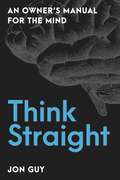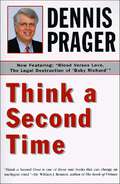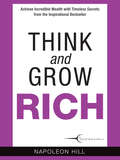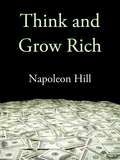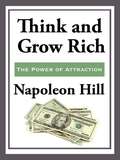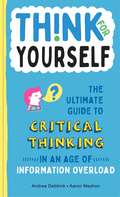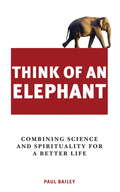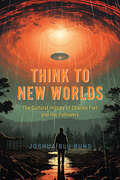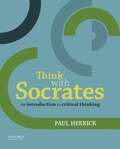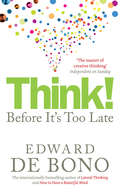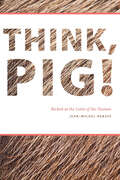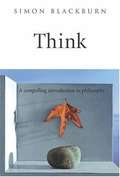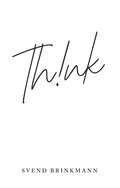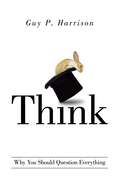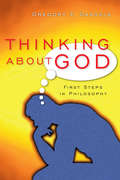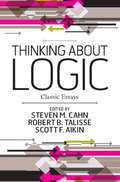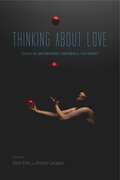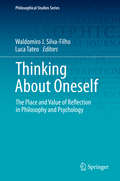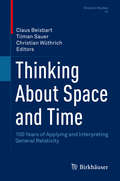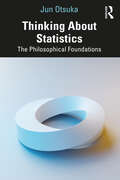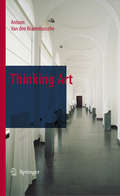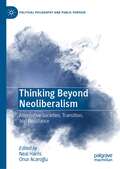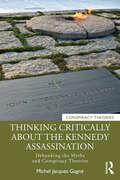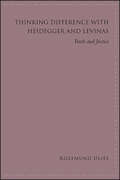- Table View
- List View
Think Straight: An Owner's Manual for the Mind
by Jon GuyPut simply, Think Straight is an owner&’s manual for the human brain. Drawing from the vast history of scientific and cognitive research, this book is a tour de force through the science and philosophy of the human mind, and what it means to think as a rational human being in the 21st century. Our world is awash in mis- and disinformation, baseless conspiracy theories, New Age ideology, anti-science propaganda, and all manner of magical thinking. Pseudo-experts fill the airwaves with false and bogus claims, news media twist and spin information to suit their ends, celebrities and corporations push evidence-free beliefs on their followers, and politicians continue to mislead the masses with false promises and bad thinking. In careful detail, author Jon Guy investigates the art of thinking critically, offering readers the ability to empower themselves and our society at large.In order to think critically, we must also learn what it means to know, what knowledge is, how to investigate, how to question, and how everything from computer algorithms written by geniuses to psychological traits embedded in us from our evolutionary origins conspire to construct a model of reality that we have much reason to doubt. The human mind is not only the most powerful and complex structure ever discovered, it is also riddled with a host of flaws, shortcomings, errors, and limitations, most of which none of us are ever made aware of. Critical thinking is the ability to both capitalize on the strengths and power of human cognition, as well as understand and combat the error-prone nature of our brains. Think Straight encourages us to accept that not everything we think is true and explores how we can compensate for the many errors of our minds.Backed by the best available research and data, and written in clear and decisive language, Think Straight provides readers with the proper guidance and tools to improve your thinking, inform your decisions, avoid fraud and deceit, and make the world a better place to live and prosper.
Think a Second Time
by Dennis PragerWhat are the two great lies of the 20th century? Is there a solution to evil? What matters more, blood or love? Can a good man go to a striptease show? Do you think you have the answers? ...Think a second time. Dennis Prager, theologian and philosopher turned talk-show host, is one of the most brilliant and compelling voices in America today. His extraordinarily popular radio show with the signature sign-off, "Think a second time," coupled with his own biweekly newsletter, has firmly established him as a fixture in intellectual communities nationwide. In Think a Second Time, Prager blends a rigorous and scholarly education with utterly original thinking on current events. From the dangers of idealism to the roots of extremism to his thoughts on God and an afterlife, Prager offers challenging answers to up-to-the-minute questions: Should a single woman have a child? Why don't good homes always produce good children? Is America really racist? Why does the Holocaust not negate the existence of God? Now, with an entirely new section on the precedent-setting "Baby Richard" custody case and an exploration of the issue of blood versus love, Prager continues to demonstrate his ability to draw clear moral lines in the sands of our very troubled times.
Think and Grow Rich
by Napoleon Hill Katherine HurstThink and Grow Rich is the wildly successful motivational book from personal development author, Napoleon Hill. Having sold over 30 million copies over the past 70 years alone, this groundbreaking volume reveals the secrets of hundreds of the world's most affluent people - exposing the thought-processes and success mindset that can help you too, to enjoy unlimited prosperity and abundance. The thirteen step program found in this book has everything you need to set you on the path to incredible wealth and success. Regardless of your current circumstances, education or business experience... once you begin to read this book, you'll have access to the truths and lessons that can teach any man or woman - young or old, rich or poor - to turn their dreams for an abundant life into a reality. With this book, the formula for everything you desire - to be applied in ALL areas of life - is in your hands. Simple, direct, but incredibly powerful too - this book has the potential to change your life for the better. Are you ready? The formula for prosperity - to be applied in ALL areas of your life - is within your reach.
Think and Grow Rich
by Napoleon HillThink and Grow Rich is a motivational personal development and self-help book written by Napoleon Hill and inspired by a suggestion from Scottish-American businessman Andrew Carnegie. While the title implies that this book deals only with how to get rich, the author explains that the philosophy taught in the book can be used to help people succeed in all lines of work and to do or be almost anything they want
Think and Grow Rich: Large Print Edition (Think And Grow Rich Ser.)
by Napoleon HillThink and Grow Rich is a motivational personal development and self-help book written by Napoleon Hill and inspired by a suggestion from Scottish-American businessman Andrew Carnegie. While the title implies that this book deals only with how to get rich, the author explains that the philosophy taught in the book can be used to help people succeed in all lines of work and to do or be almost anything they want
Think for Yourself: The Ultimate Guide to Critical Thinking in an Age of Information Overload
by Andrea DebbinkMiddle school is a time of change, when things begin to look different and assumptions start to be questioned, and today more than ever it’s tough to know what to believe. This unique and timely book won&’t tell you what to think—that’s up to you!—but it will show you how to think more deeply about your own life and current events. Covering a wide range of subjects affecting the world today, including human and animal rights, social media, cyber bullying, the refugee crisis, and more, THINK FOR YOURSELF will help you to learn how to ask questions, analyze evidence, and use logic to draw conclusions, so you can solve problems and make smart decisions. Each chapter of the book covers one key step in the critical thinking process, and includes a real-world example to help convey the importance and relevance of every step: <P><P>Ask Questions: If you want to be a critical thinker, it helps to be curious. It’s normal to wonder about the world around us. Some questions are big, and some are small. Sometimes questions can spark debate and argument. All critical thinking starts with at least one question. <P><P> Gather Evidence: First, find information—from making observations to interviewing experts to researching a topic online or in books. Then make connections and draw conclusions. <P><P>Evaluating Evidence: Smart thinkers evaluate the importance, accuracy and relevancy of the information they gather. <P><P>Getting Curious: Consider other points of view, examine your own point of view, understand the power of emotion, and practice empathy. <P><P>Draw Conclusions: The final step in the critical thinking process, this is based on reason and evidence. Revisit your original question, review the evidence and what you’ve learned, and consider your values. And remember: critical thinking doesn’t stop when you’ve reached a decision. Learn how to discuss and debate other points of view. Then keep growing. Sometimes you might change your mind—that’s OK, too! Featuring profiles of real-life inspiring young critical thinkers from around the world, checklists, quizzes, and activities, THINK FOR YOURSELF is a clever and fun illustrated guide that teaches middle schoolers that even young people can make a difference in the world just by thinking smart and understanding. <P><P>INCLUDES:Your Turn: activities to help connect ideas to readers’ lives <P><P>Quizzes <P><P>Profiles of inspiring young critical thinkers <P><P>A Reading List for Young Thinkers <P><P>Teacher's guides <P><P>Plus a table of contents, index, and glossary for easy searching
Think of an Elephant
by Paul BaileyCombining science and spirituality to reveal the true nature of the universe - this book will change perceptions, inspire mind-shifts and alter the way we see the world, forever.
Think to New Worlds: The Cultural History of Charles Fort and His Followers
by Joshua Blu BuhsHow a writer who investigated scientific anomalies inspired a factious movement and made a lasting impact on American culture. Flying saucers. Bigfoot. Frogs raining from the sky. Such phenomena fascinated Charles Fort, the maverick writer who scanned newspapers, journals, and magazines for reports of bizarre occurrences: dogs that talked, vampires, strange visions in the sky, and paranormal activity. His books of anomalies advanced a philosophy that saw science as a small part of a larger system in which truth and falsehood continually transformed into one another. His work found a ragged following of skeptics who questioned not only science but the press, medicine, and politics. Though their worldviews varied, they shared compelling questions about genius, reality, and authority. At the center of this community was adman, writer, and enfant terrible Tiffany Thayer, who founded the Fortean Society and ran it for almost three decades, collecting and reporting on every manner of oddity and conspiracy. In Think to New Worlds, Joshua Blu Buhs argues that the Fortean effect on modern culture is deeper than you think. Fort’s descendants provided tools to expand the imagination, explore the social order, and demonstrate how power is exercised. Science fiction writers put these ideas to work as they sought to uncover the hidden structures undergirding reality. Avant-garde modernists—including the authors William Gaddis, Henry Miller, and Ezra Pound, as well as Surrealist visual artists—were inspired by Fort’s writing about metaphysical and historical forces. And in the years following World War II, flying saucer enthusiasts convinced of alien life raised questions about who controlled the universe. Buhs’s meticulous and entertaining book takes a respectful look at a cast of oddballs and eccentrics, plucking them from history’s margins and spotlighting their mark on American modernism. Think to New Worlds is a timely consideration of a group united not only by conspiracies and mistrust of science but by their place in an ever-expanding universe rich with unexplained occurrences and visionary possibilities.
Think with Socrates: An Introduction to Critical Thinking
by Paul HerrickBrief yet comprehensive, Think with Socrates: An Introduction to Critical Thinking uses the methods, ideas, and life of Socrates as a model for critical thinking. It offers a more philosophical, historical, and accessible introduction than longer textbooks while still addressing all of the key topics in logic and argumentation. Applying critical thinking to the Internet, mass media, advertising, personal experience, expert authority, the evaluation of sources, writing argumentative essays, and forming a worldview, Think with Socrates resonates with today's students and teaches them how to apply critical thinking in the real world. At the same time, it covers the ancient intellectual roots and history of the field, placing critical thinking in its larger context to help students appreciate its perennial value. Author Paul Herrick incorporates original sources from newspapers, a variety of media, and philosophical writing, along with engaging "interludes" featuring selections from Plato's dialogues. A Companion Website at www.oup.com/us/herrick offers resources for students and instructors.
Think!: Before It's Too Late
by Edward de BonoThe world is full of problems and conflicts. So why can we not solve them? According to Edward de Bono, world thinking cannot solve world problems because world thinking is itself the problem. And this is getting worse: we are so accustomed to readily available information online that we search immediately for the answers rather than thinking about them. Our minds function like trying to drive a car using only one wheel. There's nothing wrong with that one wheel - conventional thinking - but we could all get a lot further if we used all four... De Bono examines why we think the way we do from a historical perspective and uses some of his famous thinking techniques, such as lateral thinking, combined with new ideas to show us how to change the way we think. If we strengthen our ability and raise our thinking level, other areas of our life - both personal and business success - will improve.De Bono is the master of the original big 'concept' book and his enticement to us to use our minds as constructively as possible should appeal to a whole new generation of fans.
Think, Pig!: Beckett at the Limit of the Human
by Jean-Michel RabatéThis book examines Samuel Beckett’s unique lesson in courage in the wake of humanism’s postwar crisis—the courage to go on living even after experiencing life as a series of catastrophes.Rabaté, a former president of the Samuel Beckett Society and a leading scholar of modernism, explores the whole range of Beckett’s plays, novels, and essays. He places Beckett in a vital philosophical conversation that runs from Bataille to Adorno, from Kant and Sade to Badiou. At the same time, he stresses Beckett’s inimitable sense of metaphysical comedy.Foregrounding Beckett’s decision to write in French, Rabaté inscribes him in a continental context marked by a “writing degree zero” while showing the prescience and ethical import of Beckett’s tendency to subvert the “human” through the theme of the animal. Beckett’s “declaration of inhuman rights,” he argues, offers the funniest mode of expression available to us today.
Think: A Compelling Introduction to Philosophy
by Simon Blackburn'Think offers a tour of philosophical thinking. . . central to our understanding of the world and our position in it. ' -Sunday Times 29/04/01'highly recommended' -TLS 27/04/01The one book every smart person should read. ' - Time Magazine, 10. 4. 99'Simon Blackburn's lucidly elegant essay is a guide to the most central concerns of philosophy. . . A beautifully clear account of the chief arguments in each debate. Blackburn is an accomplished philosopher, which makes this a valuable little book. ' Sunday Times, 7. 11. 99
Think: In Defence of a Thoughtful Life
by Svend BrinkmannA defining feature of being human is our ability to think. We refer to ourselves, after all, as Homo sapiens. But in a world where experiencing and achieving as much as possible is the number one preoccupation, there is little room for reflection. Technology is also making everything easier, eroding the need for us to think at all. Of course deep, critical thinking can be difficult, sometimes painful, and it takes time. But it is fundamental to our well-being. In this new book, bestselling philosopher and psychologist Svend Brinkmann argues for a return to the thoughtful life, where we learn to think well, to think deeply, to lose ourselves in reverie and tune in to our inner voice. By spending time in our thoughts and letting them wander freely, we will discover that thinking is one of the most enriching things we can do in life – and one of the most human, too.
Think: Why You Should Question Everything
by Guy P. HarrisonThink more critically, learn to question everything, and don't let your ownbrain trip you up. This fresh and exciting approach to science, skepticism, and critical thinking will enlighten and inspire readers of all ages. With a mix of wit and wisdom, it challenges everyone to think like a scientist, embrace the skeptical life, and improve their critical thinking skills. Thinkshows you how to better navigate through the maze of biases and traps that are standard features of every human brain. These innate pitfalls threaten to trick us into seeing, hearing, thinking, remembering, and believing things that are not real or true. Guy Harrison's straightforward text will help you trim away the nonsense, deflect bad ideas, and keep both feet firmly planted in reality. With an upbeat and friendly tone, Harrison shows how it's in everyone's best interest to question everything. He brands skepticism as a constructive and optimistic attitude--a way of life that anyone can embrace. An antidote to nonsense and delusion, this accessible guide to critical thinking is the perfect book for anyone seeking a jolt of inspiration.
Thinking About God: First Steps in Philosophy
by Gregory E. GanssleCan we really think about God? Can we prove God?s existence? What about faith? Are there good reasons to believe in the Christian God? What about evil? Can we really know with our finite minds anything for sure about a transcendent God? Can we avoid thinking about God? The real problem, says philosopher Gregory E. Ganssle, is not whether we can think about God, but whether we will think well or poorly about God. Admittedly there is a lot of bad thinking going around. But Ganssle, who teaches students, wants to help us think better, especially about God. He thinks philosophy can actually help. In the first part of this book Ganssle lays the groundwork for clear and careful thinking, providing us an introductory guide to doing philosophy. In the second part Ganssle then takes us through the process of thinking well about God in particular. He asks us to consider whether there are good reasons to believe that God exists. He thinks there are! In a third part Ganssle addresses the thorny issue of the existence both of God and of evil. He thinks there?s a valid way through this problem. In the final part Ganssle helps us thread our way through questions like: What is God like? What can God do? What can God know? How does God communicate? He thinks that there are some clear answers to these questions, at least if you?re talking about the God of Christianity. If you're looking for your first book for thinking clearly and carefully about God, then you'll appreciate the good thinking found in this book.
Thinking About Logic
by Steven M. Cahn Robert B. Talisse Scott F. AikinThinking about Logic is an accessible and thought-provoking collection of classic articles in the philosophy of logic. An ideal companion to any formal logic course or textbook, this volume illuminates how logic relates to perennial philosophical issues about knowledge, meaning, rationality, and reality. The editors have selected each essay for its brevity, clarity, and impact and have included insightful introductions and discussion questions. The puzzles raised will help readers acquire a more thorough understanding of fundamental logic concepts and a firmer command of the connections between formal logic and other areas of philosophical study: epistemology, philosophy of language, philosophy of science, and metaphysics.
Thinking About Logic
by Steven M. Cahn Robert B. Talisse Scott F. AikinThinking about Logic is an accessible and thought-provoking collection of classic articles in the philosophy of logic. An ideal companion to any formal logic course or textbook, this volume illuminates how logic relates to perennial philosophical issues about knowledge, meaning, rationality, and reality. The editors have selected each essay for its brevity, clarity, and impact and have included insightful introductions and discussion questions. The puzzles raised will help readers acquire a more thorough understanding of fundamental logic concepts and a firmer command of the connections between formal logic and other areas of philosophical study: epistemology, philosophy of language, philosophy of science, and metaphysics.
Thinking About Love: Essays in Contemporary Continental Philosophy
by Diane Enns Antonio CalcagnoDoes love command an ineffability that remains inaccessible to the philosopher?Thinking About Love considers the nature and experience of love through the writing of well-known Continental philosophers such as Hannah Arendt, Simone de Beauvoir, Jacques Derrida, and Maurice Merleau-Ponty. Evolving forms of social organization, rapid developments in the field of psychology, and novel variations on relationships demand new approaches to and ways of talking about love. Rather than offering prescriptive claims, this volume explores how one might think about the concept philosophically, without attempting to resolve or alleviate its ambiguities, paradoxes, and limitations. The essays focus on the contradictions and limits of love, manifested in such phenomena as trust, abuse, grief, death, violence, politics, and desire. An erudite examination of the many facets of love, this book fills a lacuna in the philosophy of this richly complicated topic.Along with the editors, the contributors are Sophie Bourgault, John Caruana, Christina M. Gschwandtner, Marguerite La Caze, Alphonso Lingis, Christian Lotz, Todd May, Dawne McCance, Dorothea Olkowski, Felix Ó Murchadha, Fiona Utley, and Mélanie Walton.
Thinking About Oneself: The Place and Value of Reflection in Philosophy and Psychology (Philosophical Studies Series #141)
by Luca Tateo Waldomiro J. Silva-FilhoThis book advances our theoretical understanding of the human experience. By overcoming dualities such as the relationship between reflection and action, it allows a more in-depth analysis of how concepts constitute complementary parts of the complex human thinking to be developed.Presenting texts written by leading philosophers and psychologists, it provides a comprehensive overview of the current state of theoretical elaboration, which is then used to discuss the place and value of reflection in moral and epistemic scenes. These topics are accessible to experts and young scholars in the field alike, and offer scope for further reflections that could improve our understanding beyond the existing models and “-isms”. The novelty of the book is in the dialogue established between several perspectives (e.g. philosophers and psychologists; Europe, America and Asia; etc.). The contributions of philosophers and psychologists establish a fruitful dialogue, so that readers realize that disciplinary divisions are overcome through dialogue and the common object of inquiry: the way human beings reflect and act in their everyday experiences.
Thinking About Space and Time: 100 Years of Applying and Interpreting General Relativity (Einstein Studies #15)
by Tilman Sauer Claus Beisbart Christian WüthrichThis volume offers an integrated understanding of how the theory of general relativity gained momentum after Einstein had formulated it in 1915. Chapters focus on the early reception of the theory in physics and philosophy and on the systematic questions that emerged shortly after Einstein's momentous discovery. They are written by physicists, historians of science, and philosophers, and were originally presented at the conference titled Thinking About Space and Time: 100 Years of Applying and Interpreting General Relativity, held at the University of Bern from September 12-14, 2017. By establishing the historical context first, and then moving into more philosophical chapters, this volume will provide readers with a more complete understanding of early applications of general relativity (e.g., to cosmology) and of related philosophical issues. Because the chapters are often cross-disciplinary, they cover a wide variety of topics related to the general theory of relativity. These include:Heuristics used in the discovery of general relativityMach's PrincipleThe structure of Einstein's theoryCosmology and the Einstein worldStability of cosmological modelsThe metaphysical nature of spacetimeThe relationship between spacetime and dynamicsThe Geodesic PrincipleSymmetriesThinking About Space and Time will be a valuable resource for historians of science and philosophers who seek a deeper knowledge of the (early and later) uses of general relativity, as well as for physicists and mathematicians interested in exploring the wider historical and philosophical context of Einstein's theory.
Thinking About Statistics: The Philosophical Foundations
by Jun OtsukaSimply stated, this book bridges the gap between statistics and philosophy. It does this by delineating the conceptual cores of various statistical methodologies (Bayesian/frequentist statistics, model selection, machine learning, causal inference, etc.) and drawing out their philosophical implications. Portraying statistical inference as an epistemic endeavor to justify hypotheses about a probabilistic model of a given empirical problem, the book explains the role of ontological, semantic, and epistemological assumptions that make such inductive inference possible. From this perspective, various statistical methodologies are characterized by their epistemological nature: Bayesian statistics by internalist epistemology, classical statistics by externalist epistemology, model selection by pragmatist epistemology, and deep learning by virtue epistemology. Another highlight of the book is its analysis of the ontological assumptions that underpin statistical reasoning, such as the uniformity of nature, natural kinds, real patterns, possible worlds, causal structures, etc. Moreover, recent developments in deep learning indicate that machines are carving out their own "ontology" (representations) from data, and better understanding this—a key objective of the book—is crucial for improving these machines’ performance and intelligibility. Key Features Without assuming any prior knowledge of statistics, discusses philosophical aspects of traditional as well as cutting-edge statistical methodologies. Draws parallels between various methods of statistics and philosophical epistemology, revealing previously ignored connections between the two disciplines. Written for students, researchers, and professionals in a wide range of fields, including philosophy, biology, medicine, statistics and other social sciences, and business. Originally published in Japanese with widespread success, has been translated into English by the author.
Thinking Art
by Antoon Van BraembusscheIn the twentieth century, avant-garde movements have pushed the concept of art far beyond its traditional boundaries. In this dynamical process of constant renewal the prestige of thinking about art as a legitimizing practice has come to the fore. So it is hardly surprising that the past decades have been characterized by a revival or even breakthrough of philosophy of art as a discipline. However, the majority of books on aesthetics fail to combine a systematical philosophical discourse with a real exploration of art practice. Thinking Art attempts to deal with this traditional shortcoming. It is indeed not only an easily accessible and systematic account of the classical, modern and postmodern theories of art, but also concludes each chapter with an artist's studio in which the practical relevance of the discussed theory is amply demonstrated by concrete examples. Moreover, each chapter ends with a section on further reading, in which all relevant literature is discussed in detail. Thinking Art provides its readers with a theoretical framework that can be used to think about art from a variety of perspectives. More particularly it shows how a fruitful cross-fertilization between theory and practice can be created. This book can be used as a handbook within departments of philosophy, history of art, media and cultural studies, cultural history and, of course, within art academies. Though the book explores theories of art from Plato to Derrida it does not presuppose any acquaintance with philosophy from its readers. It can thus be read also by artists, art critics, museum directors and anyone interested in the meaning of art.
Thinking Beyond Neoliberalism: Alternative Societies, Transition, and Resistance (Political Philosophy and Public Purpose)
by Neal Harris Onur AcaroğluThis book brings together leading academics and activists to address the possibilities for qualitative social change beyond neoliberalism, providing introductory essays on alternative societies, transition, and resistance. Bringing together discussions on universal basic income, actually existing communism, parecon, circular economies, workers co-operatives, ‘fully automated luxury communism,' trade unionism, and party politics, the volume provides one of the first scholarly interventions to systematically evaluate possibilities for transition and resistance across theoretical, political, and disciplinary traditions.
Thinking Critically About the Kennedy Assassination: Debunking the Myths and Conspiracy Theories (Conspiracy Theories)
by Michel Jacques GagnéThinking Critically About the Kennedy Assassination uses the tools of critical thinking, historical research, and philosophical inquiry to debunk the many myths and conspiracy theories surrounding JFK’s shocking and untimely death. As we approach the 60th anniversary of the violent public assassination of President John F. Kennedy, over half of all Americans surveyed continue to believe that he was killed by a conspiracy involving multiple assassins. Through its reasoned and detailed analysis of the content and evolution of JFK conspiracy narratives, this book also serves as a comprehensive case study of paranoid reasoning and modern mythmaking. The book’s opening chapters lay out the "official" academic consensus concerning the Kennedy assassination (better known as the "Lone Gunman Theory") and discuss the origins of popular interpretations of Kennedy’s life and death, such as the nostalgic myth of "Camelot," the unsympathetic "Irish Mafia" narrative, and the many conspiracy theories critical of both. Subsequent sections scrutinize the alleged motives of leading conspiracy suspects, the ballistic, forensic, and medical evidence related to JFK’s murder, and the most popular "proofs" of an enduring government cover- up. The book concludes that no clear evidence exists to suggest that JFK was the victim of a conspiracy and ends with a discussion of the causes and consequences of paranoid thinking in contemporary public discourse. This volume will appeal to students of history, politics, psychology, and cultural and media studies, and to a broader audience interested in American history, critical thinking, and conspiracy thinking.
Thinking Difference with Heidegger and Levinas: Truth and Justice (SUNY series in Contemporary French Thought)
by Rozemund UljéeTracing the relationship between truth and justice as articulated by Heidegger and Levinas, Rozemund Uljée presents the relation between the two thinkers as a subtle, profound, and complex rapport, which includes both their proximity and radical difference. This rapport is conceived not as a confrontation, but rather as a transformation, as Levinas's notion of justice does not renounce Heidegger's account of truth and its deployment. Thinking Difference with Heidegger and Levinas shows how the ethical relation transforms the essence and task of philosophy in its entirety, since it shifts the orientation of philosophy and the task of thinking from its concern with truth as ground or foundation to a question of justice. As a result, philosophy is no longer riveted to Being and its truth, but answers to the call for justice and must be conceived of as infinite commencement, where its impossibility to totalize meaning ensures that it remains open to the alterity of transcendence.
